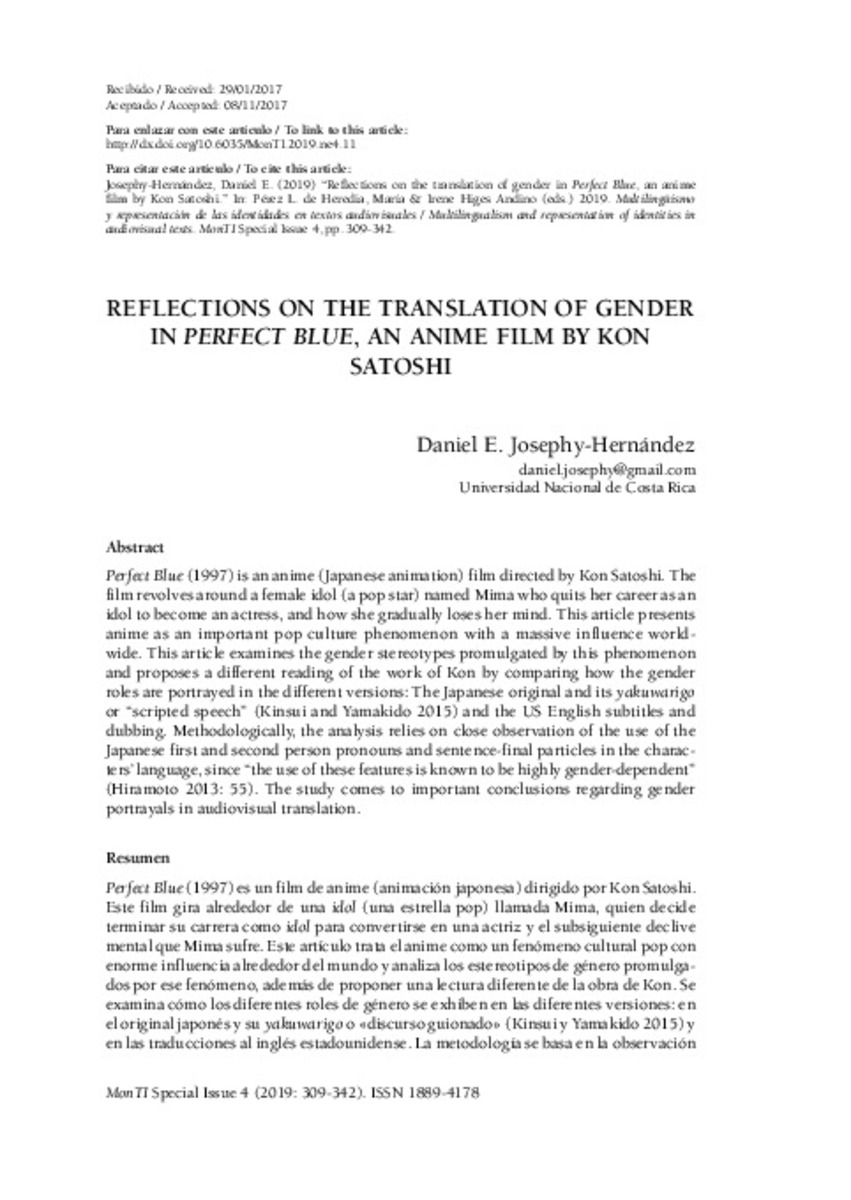Mostrar el registro sencillo del ítem
Reflections on the translation of gender in Perfect Blue, an anime film by Kon Satoshi
| dc.contributor.author | Josephy-Hernández, Daniel E. | |
| dc.date.accessioned | 2019-10-24T07:07:17Z | |
| dc.date.available | 2019-10-24T07:07:17Z | |
| dc.date.issued | 2019 | |
| dc.identifier.citation | JOSEPHY-HERNÁNDEZ, Daniel E. Reflections on the translation of gender in Perfect Blue, an anime film by Kon Satoshi. MonTI. Monografías de Traducción e Interpretación, 2019, núm. esp. 3, p. 309-342. | |
| dc.identifier.issn | 1889-4178 | |
| dc.identifier.issn | 1989-9335 (electrònic) | |
| dc.identifier.uri | http://hdl.handle.net/10234/184488 | |
| dc.description.abstract | Perfect Blue (1997) is an anime (Japanese animation) film directed by Kon Satoshi. The film revolves around a female idol (a pop star) named Mima who quits her career as an idol to become an actress, and how she gradually loses her mind. This article presents anime as an important pop culture phenomenon with a massive influence worldwide. This article examines the gender stereotypes promulgated by this phenomenon and proposes a different reading of the work of Kon by comparing how the gender roles are portrayed in the different versions: The Japanese original and its yakuwarigo or “scripted speech” (Kinsui and Yamakido 2015) and the US English subtitles and dubbing. Methodologically, the analysis relies on close observation of the use of the Japanese first and second person pronouns and sentence-final particles in the characters’ language, since “the use of these features is known to be highly gender-dependent” (Hiramoto 2013: 55). The study comes to important conclusions regarding gender portrayals in audiovisual translation. | en_US |
| dc.description.abstract | Perfect Blue (1997) es un film de anime (animación japonesa) dirigido por Kon Satoshi. Este film gira alrededor de una idol (una estrella pop) llamada Mima, quien decide terminar su carrera como idol para convertirse en una actriz y el subsiguiente declive mental que Mima sufre. Este artículo trata el anime como un fenómeno cultural pop con enorme influencia alrededor del mundo y analiza los estereotipos de género promulgados por ese fenómeno, además de proponer una lectura diferente de la obra de Kon. Se examina cómo los diferentes roles de género se exhiben en las diferentes versiones: en el original japonés y su yakuwarigo o «discurso guionado» (Kinsui y Yamakido 2015) y en las traducciones al inglés estadounidense. La metodología se basa en la observación del uso de los pronombres de primera y segunda persona y las partículas utilizadas al final de la oración del idioma japonés, ya que «the use of these features is known to be highly gender-dependent» («se sabe que el uso de estos rasgos lingüísticos están muy ligados al género del hablante») (Hiramoto 2013: 55). El estudio llega a conclusiones importantes respecto a los roles de género en la traducción audiovisual. | es_ES |
| dc.format.extent | 309-342 | |
| dc.format.mimetype | application/pdf | |
| dc.language.iso | spa | |
| dc.publisher | Universitat Jaume I | |
| dc.publisher | Universitat de València | |
| dc.publisher | Universitat d' Alacant | |
| dc.relation.isPartOf | MonTI, 2019, núm. esp. 4 | |
| dc.rights.uri | http://creativecommons.org/licenses/by/4.0/ | * |
| dc.subject | anime | |
| dc.subject | Kon Satoshi | |
| dc.subject | Perfect Blue | |
| dc.subject | traducción audiovisual | |
| dc.subject | género | |
| dc.title | Reflections on the translation of gender in Perfect Blue, an anime film by Kon Satoshi | es_ES |
| dc.title.alternative | Reflections on the translation of gender in Perfect Blue, an anime film by Kon Satoshi | en_US |
| dc.type | info:eu-repo/semantics/article | |
| dc.identifier.doi | 10.6035/MonTI.2019.ne4.11 | |
| dc.rights.accessRights | info:eu-repo/semantics/openAccess | |
| dc.relation.publisherVersion | http://www.e-revistes.uji.es/index.php/monti/article/view/4127 |
Ficheros en el ítem
Este ítem aparece en la(s) siguiente(s) colección(ones)
-
MonTi_ 2019 _núm.esp_4 [14]
Número especial 4








